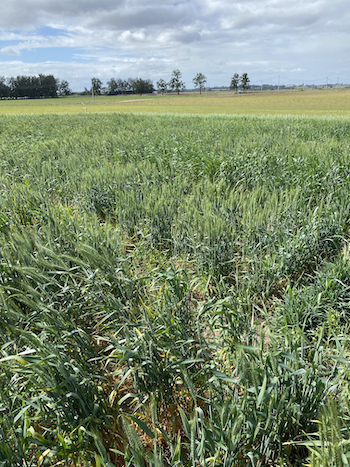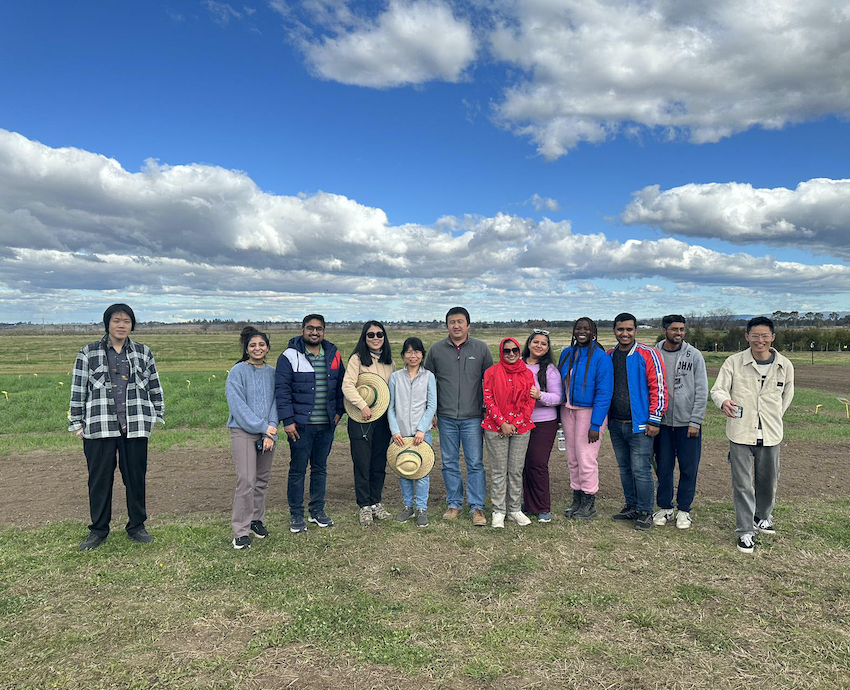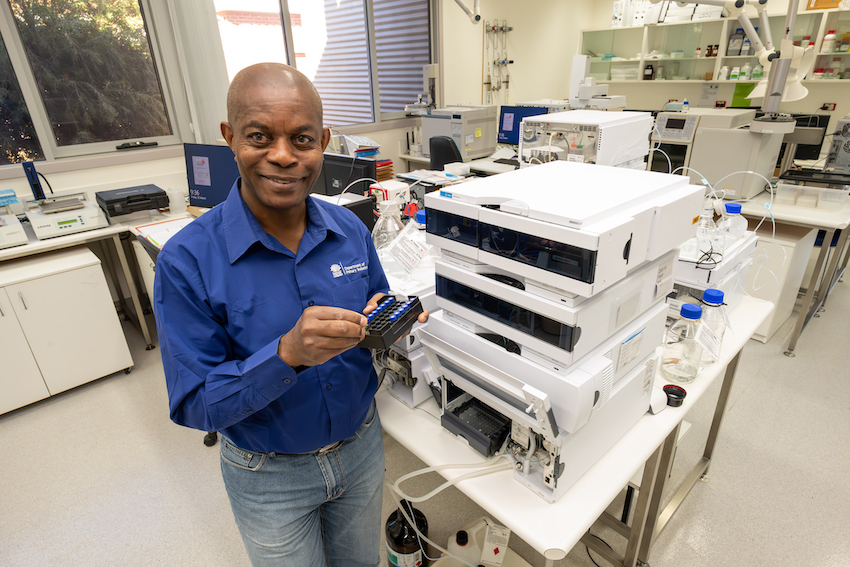Plants can adapt to the large changes in temperatures that occur during the day and across seasons. This intrinsic ability and its various biological pathways are being targeted by four GRDC investments that are seeking new opportunities to breed for heat tolerance in wheat.
These in-depth dives into heat-responsive biochemical processes are being undertaken using highly diverse wheat populations. The contrast provided by susceptible and tolerant lines is being exploited to ultimately identify new traits as the researchers develop novel screening technology.
This trait discovery work aims to develop selection tools for use by commercial breeders, some of whom are in-kind partners to these projects. These selection tools could take the form of DNA markers or next-generation, high-throughput phenotyping tools, such as hyperspectral devices linked to machine learning algorithms.
Work towards these goals got underway in 2023 and an outline of two projects was presented in the March issue of GroundCover™. In the second part of this series, coverage of the final two projects is presented.
PROJECT 3: The source-sink relationship
 Western Sydney University’s River Farm in Richmond, NSW. Photo: Western Sydney University
Western Sydney University’s River Farm in Richmond, NSW. Photo: Western Sydney University
The steps between sunlight hitting the leaf and sugars making their way to grain are the specific targets of research by Professor Zhonghua Chen and his research team. He is an Australian Research Council (ARC) Future Fellow at Western Sydney University.
“The leaves act as the ‘source’ and the grain as the ‘sink’ for starches made during grain filling,” Professor Chen says. “Heat has a large impact on source-sink dynamics. However, there are limited research methods available that allow us to screen for adaptations in source-sink biology and select for heat tolerance adaptations in wheat.”
Source-sink biology encompasses three broad aspects of plants: leaf structural traits, the chloroplasts where photosynthesis occurs, and the leaf veins that connect the source and sink.
Heat also imposes an additional block on grain production by reducing pollen fertility and, therefore, pollen viability. This, too, is a good indicator for heat tolerance in wheat.
What was needed to exploit these kinds of adaptations, says Professor Chen, is the opportunity to explore source-sink biology with an eye to identifying phenotypic traits and molecular markers that aid in selection of heat-tolerant variants.
“We want ways to efficiently select material that has ideal leaf structural traits, stay green longer, have chloroplasts that are more tolerant to heat and produce viable pollen,” he says. “These are traits that could allow crops to fill grain despite prolonged higher temperatures.”
This work is being undertaken by a large research team that includes Jay Bose and Oula Ghannoum at Western Sydney University, Rajeev Varshney and Chengdao Li at Murdoch University, Meixue Zhou at University of Tasmania, and three research technicians and four PhD students.
The team also collaborates with the University of Haifa in Israel, the International Maize and Wheat Improvement Center (CIMMYT) and Australian Grains Technology (AGT). This project will involve multiple field and glasshouse trials in New South Wales, Western Australia and Tasmania.
The Western Sydney University team is focusing especially on heat-tolerance adaptations of leaf structure and chloroplasts. A key focus is on biochemicals that can be readily measured when screening wheat germplasm. Potential targets include levels of an amino acid (proline) and sugars that are known to vary under heat stress.
Murdoch University in Western Australia is drawing on its previous heat-tolerance work in barley and is deploying its specialised heat chambers to explore spike fertility in wheat.
Meantime, the University of Tasmania will focus on pollen viability. To avoid the need for heatwaves before screening for pollen fertility, a PCR machine is used to subject the pollen to various temperature regimes. The pollen is then stained to test for viability, which results in a high-throughput score for heat tolerance.
The project collaborators are basing the analysis on a collection of 340 wheat lines. Included are 150 Australian varieties spanning new and old cultivars, 150 varieties collected in China during a previous GRDC investment conducted by the University of Tasmania, breeding lines imported from CIMMYT and wild wheat relatives imported from Israel.
Additionally, professors Rajeev Varshney and Chengdao Li are taking advantage of reduced DNA sequencing costs and the Next Generation Sequencing (NGS) platform to re-sequence the genome of tested lines. This will pave the way for genome-wide association mapping and genomic selection to select and combine novel heat tolerance traits.
“In the first round of analysis, we are aiming to test for 25 different traits related to heat tolerance in wheat,” Professor Chen says. “Over the life of the project we hope to whittle this down to about five traits that have the largest impact on heat tolerance. We’ll then use the genetic maps to identify major quantitative trait loci for heat tolerance but that also co-localise with high yield.”
As a former GRDC PhD scholar, Professor Chen is especially keen to see this project structured to maximise opportunities to benefit the growers who have invested in his PhD training.
“My career has sometimes meandered across different sectors, such as horticulture, but my core research strengths and interest are on grains,” he says. “I want to thank GRDC and growers for allowing us to do this research work.”

From left: Terry Lin, Sonali, Asad Abbas, Jing He, Dongmei Yang, Zhong-Hua Chen, Afroz Naznin, Geetika Bhandari, Oluwadamilola Dauda, Mazadul Islam, Mohammad Babla and Wei Jiang. Photo: Western Sydney University
PROJECT 4: The plant’s protective antioxidants
In the fourth investment, an exceptionally important class of metabolites – the epidermal flavonoids – are being targeted that have historically defied inclusion in phenotyping platforms and breeding programs.
This project is headed by Dr Livinus Emebiri, research scientist at the NSW Department of Primary Industries, Wagga Wagga.
Dr Emebiri explains that plant flavonoids protect cells from oxidative stress. This is a type of stress that arises due to the radical oxygen species generated during metabolism, including photosynthesis, or from fighting infections and other stresses. As such, they are classed as antioxidants.
More specifically, the epidermal flavonoids line the surface of leaves and protect the photosynthesis machinery against damage from ultraviolet light.
“While there are health benefits to humans from eating plant antioxidants, the plant produces them to protect themselves from oxidative stress, diseases and pests,” Dr Emebiri says.
In fact, research has found a correlation between flavonoid production and enhanced tolerance to cold and frost stress. Progress to tap these molecules as markers for stress tolerance pre-breeding work more broadly has, however, stalled.
The problem is that about 8000 individual flavonoids have been identified. This makes for a class of molecules that is too complex to routinely type during breeding work. Importantly, no effort has been made to bring newer phenotyping technology to help select for heat stress tolerance traits.
In a two-year, proof-of-concept study, principal investigator Dr Emebiri is undertaking to overcome that very impasse.
With GRDC investment, he has started to benchmark flavonoid levels in five heat-tolerant wheat lines and to compare them to levels in five susceptible wheat lines.
This benchmarking work will use a pre-existing and expensive biochemical method called High Performance Liquid Chromatography (HPLC) to separate and analyse flavonoids from the 10 wheat lines.

Flavonoids are being characterised as a potential basis for a new way to select for heat tolerance. Photo: Nicole Baxter
This analysis will prioritise 10 flavonoids of special interest, including one of the most abundant, called isoorientin.
This is among the most interesting of the flavonoids both in terms of plant and human health. Laboratory-based research undertaken globally has identified associations between this flavonoid and resistance to pests in maize, to stripe rust in wheat and to the pod borer pest in pigeon pea.
The results from the biochemical analysis will allow Dr Emebiri to answer the question of whether epidermal flavonoid levels are also correlated with heat tolerance in wheat.
The project is additionally designed to use the HPLC data as a benchmark to test the ability of newer, cheaper and more scalable technology to measure flavonoid levels in leaves more efficiently. He is targeting two phenotyping technologies.
The first is a hand-held flavonoid meter called Dualex, which is manufactured in France. This is an optical device that clips on leaves and measures the most abundant of the flavonoids, which includes those flavonoids targeted by the HPLC biochemical analysis.

Newer, more scalable technology for measuring flavonoids are being bencjmarked against High Performance Liquid Chromatography (HPLC) data. Photo: Nicole Baxter
The second involves using hyperspectral technology. This method involves shining light across a spectrum of wavelengths on to leaves. Biochemical differences in the leaf then cause the light to be absorbed and emitted back differently in lines that differ biologically. Computational methods are then used to identify those differences that associate with variation in heat tolerance.
Making the associations initially requires machine learning algorithms and lots of data. However, once a signal has been identified and validated, opportunities arise for a massive gain in phenotyping abilities once the hyperspectral devices are mounted on to the back of utes or on to drones. This allows for rapid, high-throughput screening of germplasm.
“There is so much potential with these flavonoids in relation to stress-tolerance research, but their complexity means they were not pursued in pre-breeding work,” Dr Emebiri says. “This project aims to break that stalemate. It is a high-risk venture but one with the potential to return large rewards.”
He further notes that benefits could extend well beyond heat tolerance traits, since the new phenotyping technology has many additional applications.
Beyond targeting other stresses, such as drought and frost, he notes that antioxidants are sought-after nutrients in human diets. Both flavonoid levels and types are of interest for health benefits, which creates opportunities for breeding nutritionally enhanced wheat varieties.
“Currently, it takes half of our research budget to carry the cost of running the HPLC biochemical analysis of flavonoids,” Dr Emebiri says.
“That also adds to the impasse in exploiting these compounds. The low cost associated with the new technology we are developing stands to make flavonoids easily and routinely targeted in ways that create a host of new opportunities.”
More information: Zhonghua Chen, z.chen@westernsydney.edu.au; Livinus Emebiri, livinus.emebiri@dpi.nsw.gov.au

























































